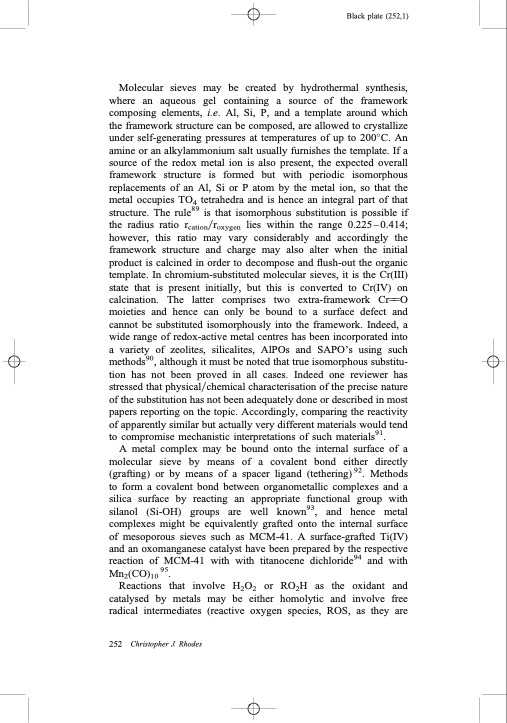
PDF Publication Title:
Text from PDF Page: 030
Black plate (252,1) Molecular sieves may be created by hydrothermal synthesis, where an aqueous gel containing a source of the framework composing elements, i.e. Al, Si, P, and a template around which the framework structure can be composed, are allowed to crystallize under self-generating pressures at temperatures of up to 200C. An amine or an alkylammonium salt usually furnishes the template. If a source of the redox metal ion is also present, the expected overall framework structure is formed but with periodic isomorphous replacements of an Al, Si or P atom by the metal ion, so that the metal occupies TO4 tetrahedra and is hence an integral part of that structure. The rule89 is that isomorphous substitution is possible if the radius ratio rcationyroxygen lies within the range 0.225 – 0.414; however, this ratio may vary considerably and accordingly the framework structure and charge may also alter when the initial product is calcined in order to decompose and flush-out the organic template. In chromium-substituted molecular sieves, it is the Cr(III) state that is present initially, but this is converted to Cr(IV) on calcination. The latter comprises two extra-framework Cr5O moieties and hence can only be bound to a surface defect and cannot be substituted isomorphously into the framework. Indeed, a wide range of redox-active metal centres has been incorporated into a variety of zeolites, silicalites, AlPOs and SAPO’s using such methods90, although it must be noted that true isomorphous substitu- tion has not been proved in all cases. Indeed one reviewer has stressed that physicalychemical characterisation of the precise nature of the substitution has not been adequately done or described in most papers reporting on the topic. Accordingly, comparing the reactivity of apparently similar but actually very different materials would tend to compromise mechanistic interpretations of such materials91. A metal complex may be bound onto the internal surface of a molecular sieve by means of a covalent bond either directly (grafting) or by means of a spacer ligand (tethering)92. Methods to form a covalent bond between organometallic complexes and a silica surface by reacting an appropriate functional group with silanol (Si-OH) groups are well known93, and hence metal complexes might be equivalently grafted onto the internal surface of mesoporous sieves such as MCM-41. A surface-grafted Ti(IV) and an oxomanganese catalyst have been prepared by the respective reaction of MCM-41 with with titanocene dichloride94 and with Mn2(CO)10 95. Reactions that involve H2O2 or RO2H as the oxidant and catalysed by metals may be either homolytic and involve free radical intermediates (reactive oxygen species, ROS, as they are 252 Christopher J. RhodesPDF Image | Properties and applications of zeolites

PDF Search Title:
Properties and applications of zeolitesOriginal File Name Searched:
003685010x12800828155007.pdfDIY PDF Search: Google It | Yahoo | Bing
CO2 Organic Rankine Cycle Experimenter Platform The supercritical CO2 phase change system is both a heat pump and organic rankine cycle which can be used for those purposes and as a supercritical extractor for advanced subcritical and supercritical extraction technology. Uses include producing nanoparticles, precious metal CO2 extraction, lithium battery recycling, and other applications... More Info
Heat Pumps CO2 ORC Heat Pump System Platform More Info
| CONTACT TEL: 608-238-6001 Email: greg@infinityturbine.com | RSS | AMP |